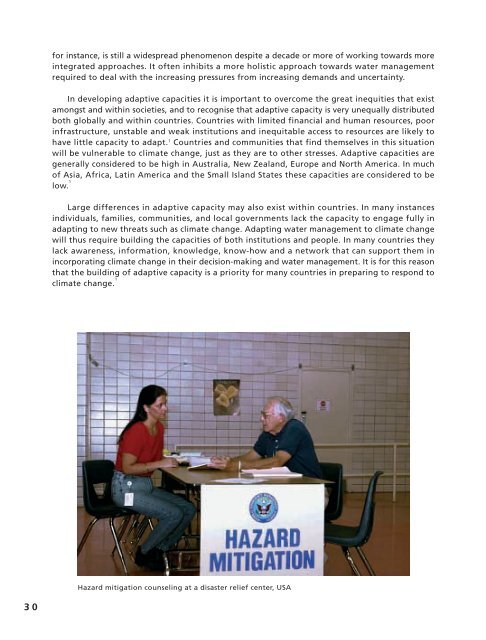Adaptation of water resources management to climate change
Adaptation of water resources management to climate change
Adaptation of water resources management to climate change
Create successful ePaper yourself
Turn your PDF publications into a flip-book with our unique Google optimized e-Paper software.
for instance, is still a widespread phenomenon despite a decade or more <strong>of</strong> working <strong>to</strong>wards moreintegrated approaches. It <strong>of</strong>ten inhibits a more holistic approach <strong>to</strong>wards <strong>water</strong> <strong>management</strong>required <strong>to</strong> deal with the increasing pressures from increasing demands and uncertainty.In developing adaptive capacities it is important <strong>to</strong> overcome the great inequities that existamongst and within societies, and <strong>to</strong> recognise that adaptive capacity is very unequally distributedboth globally and within countries. Countries with limited financial and human <strong>resources</strong>, poorinfrastructure, unstable and weak institutions and inequitable access <strong>to</strong> <strong>resources</strong> are likely <strong>to</strong>have little capacity <strong>to</strong> adapt. 1 Countries and communities that find themselves in this situationwill be vulnerable <strong>to</strong> <strong>climate</strong> <strong>change</strong>, just as they are <strong>to</strong> other stresses. Adaptive capacities aregenerally considered <strong>to</strong> be high in Australia, New Zealand, Europe and North America. In much<strong>of</strong> Asia, Africa, Latin America and the Small Island States these capacities are considered <strong>to</strong> below. 1 Large differences in adaptive capacity may also exist within countries. In many instancesindividuals, families, communities, and local governments lack the capacity <strong>to</strong> engage fully inadapting <strong>to</strong> new threats such as <strong>climate</strong> <strong>change</strong>. Adapting <strong>water</strong> <strong>management</strong> <strong>to</strong> <strong>climate</strong> <strong>change</strong>will thus require building the capacities <strong>of</strong> both institutions and people. In many countries theylack awareness, information, knowledge, know-how and a network that can support them inincorporating <strong>climate</strong> <strong>change</strong> in their decision-making and <strong>water</strong> <strong>management</strong>. It is for this reasonthat the building <strong>of</strong> adaptive capacity is a priority for many countries in preparing <strong>to</strong> respond <strong>to</strong><strong>climate</strong> <strong>change</strong>. 1Hazard mitigation counseling at a disaster relief center, USA30











![View full document [PDF 988.55 KB] - PreventionWeb](https://img.yumpu.com/47733942/1/184x260/view-full-document-pdf-98855-kb-preventionweb.jpg?quality=85)
![View full document (in French) [PDF 4.96 MB] - PreventionWeb](https://img.yumpu.com/47223870/1/184x260/view-full-document-in-french-pdf-496-mb-preventionweb.jpg?quality=85)


![View full document [PDF 25.02 MB] - PreventionWeb](https://img.yumpu.com/44204570/1/190x234/view-full-document-pdf-2502-mb-preventionweb.jpg?quality=85)
